fog light Lancia Thesis 2007 Owner handbook (in English)
[x] Cancel search | Manufacturer: LANCIA, Model Year: 2007, Model line: Thesis, Model: Lancia Thesis 2007Pages: 386, PDF Size: 8.69 MB
Page 14 of 386
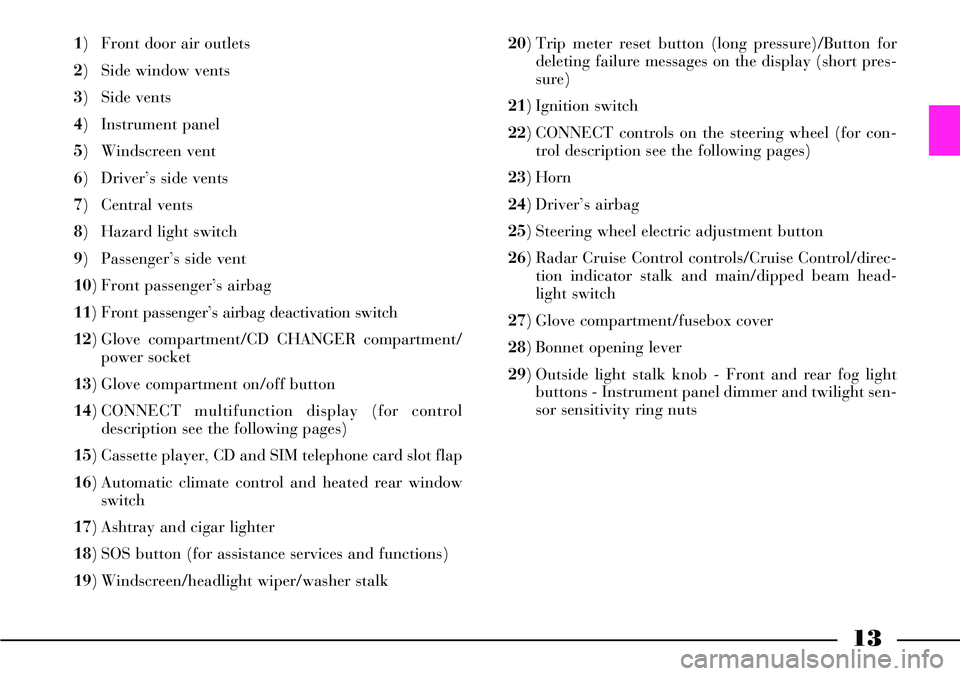
13
1) Front door air outlets
2) Side window vents
3) Side vents
4) Instrument panel
5) Windscreen vent
6) Driver’s side vents
7) Central vents
8) Hazard light switch
9) Passenger’s side vent
10) Front passenger’s airbag
11) Front passenger’s airbag deactivation switch
12) Glove compartment/CD CHANGER compartment/
power socket
13) Glove compartment on/off button
14) CONNECT multifunction display (for control
description see the following pages)
15) Cassette player, CD and SIM telephone card slot flap
16) Automatic climate control and heated rear window
switch
17) Ashtray and cigar lighter
18) SOS button (for assistance services and functions)
19) Windscreen/headlight wiper/washer stalk 20) Trip meter reset button (long pressure)/Button for
deleting failure messages on the display (short pres-
sure)
21) Ignition switch
22) CONNECT controls on the steering wheel (for con-
trol description see the following pages)
23) Horn
24) Driver’s airbag
25) Steering wheel electric adjustment button
26) Radar Cruise Control controls/Cruise Control/direc-
tion indicator stalk and main/dipped beam head-
light switch
27) Glove compartment/fusebox cover
28) Bonnet opening lever
29) Outside light stalk knob - Front and rear fog light
buttons - Instrument panel dimmer and twilight sen-
sor sensitivity ring nuts
Page 99 of 386
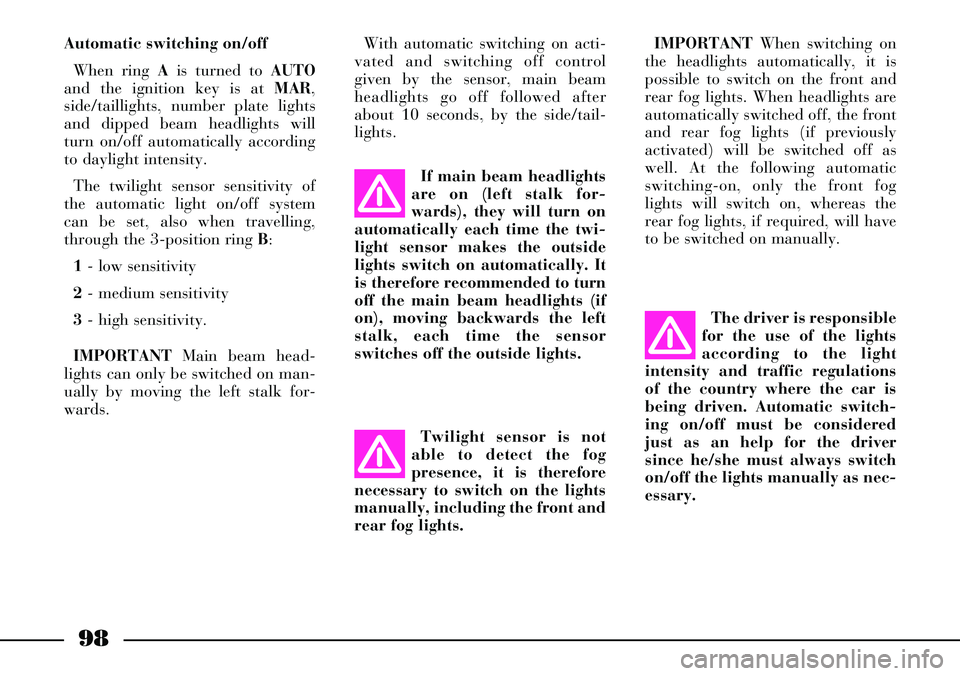
98
Automatic switching on/off
When ring Ais turned to AUTO
and the ignition key is at MAR,
side/taillights, number plate lights
and dipped beam headlights will
turn on/off automatically according
to daylight intensity.
The twilight sensor sensitivity of
the automatic light on/off system
can be set, also when travelling,
through the 3-position ring B:
1- low sensitivity
2- medium sensitivity
3- high sensitivity.
IMPORTANTMain beam head-
lights can only be switched on man-
ually by moving the left stalk for-
wards.If main beam headlights
are on (left stalk for-
wards), they will turn on
automatically each time the twi-
light sensor makes the outside
lights switch on automatically. It
is therefore recommended to turn
off the main beam headlights (if
on), moving backwards the left
stalk, each time the sensor
switches off the outside lights.
Twilight sensor is not
able to detect the fog
presence, it is therefore
necessary to switch on the lights
manually, including the front and
rear fog lights.The driver is responsible
for the use of the lights
according to the light
intensity and traffic regulations
of the country where the car is
being driven. Automatic switch-
ing on/off must be considered
just as an help for the driver
since he/she must always switch
on/off the lights manually as nec-
essary.With automatic switching on acti-
vated and switching off control
given by the sensor, main beam
headlights go off followed after
about 10 seconds, by the side/tail-
lights.IMPORTANTWhen switching on
the headlights automatically, it is
possible to switch on the front and
rear fog lights. When headlights are
automatically switched off, the front
and rear fog lights (if previously
activated) will be switched off as
well. At the following automatic
switching-on, only the front fog
lights will switch on, whereas the
rear fog lights, if required, will have
to be switched on manually.
Page 117 of 386
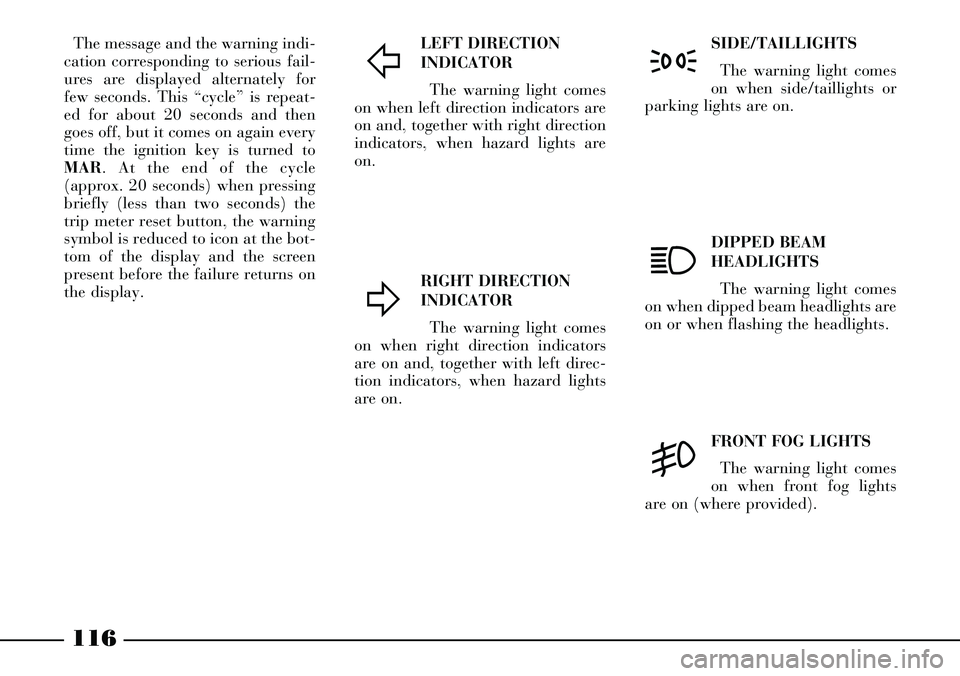
116
LEFT DIRECTION
INDICATOR
The warning light comes
on when left direction indicators are
on and, together with right direction
indicators, when hazard lights are
on.
RIGHT DIRECTION
INDICATOR
The warning light comes
on when right direction indicators
are on and, together with left direc-
tion indicators, when hazard lights
are on.SIDE/TAILLIGHTS
The warning light comes
on when side/taillights or
parking lights are on.
DIPPED BEAM
HEADLIGHTS
The warning light comes
on when dipped beam headlights are
on or when flashing the headlights.
FRONT FOG LIGHTS
The warning light comes
on when front fog lights
are on (where provided).
Ÿ
∆
3
1
5
The message and the warning indi-
cation corresponding to serious fail-
ures are displayed alternately for
few seconds. This “cycle” is repeat-
ed for about 20 seconds and then
goes off, but it comes on again every
time the ignition key is turned to
MAR. At the end of the cycle
(approx. 20 seconds) when pressing
briefly (less than two seconds) the
trip meter reset button, the warning
symbol is reduced to icon at the bot-
tom of the display and the screen
present before the failure returns on
the display.
Page 118 of 386
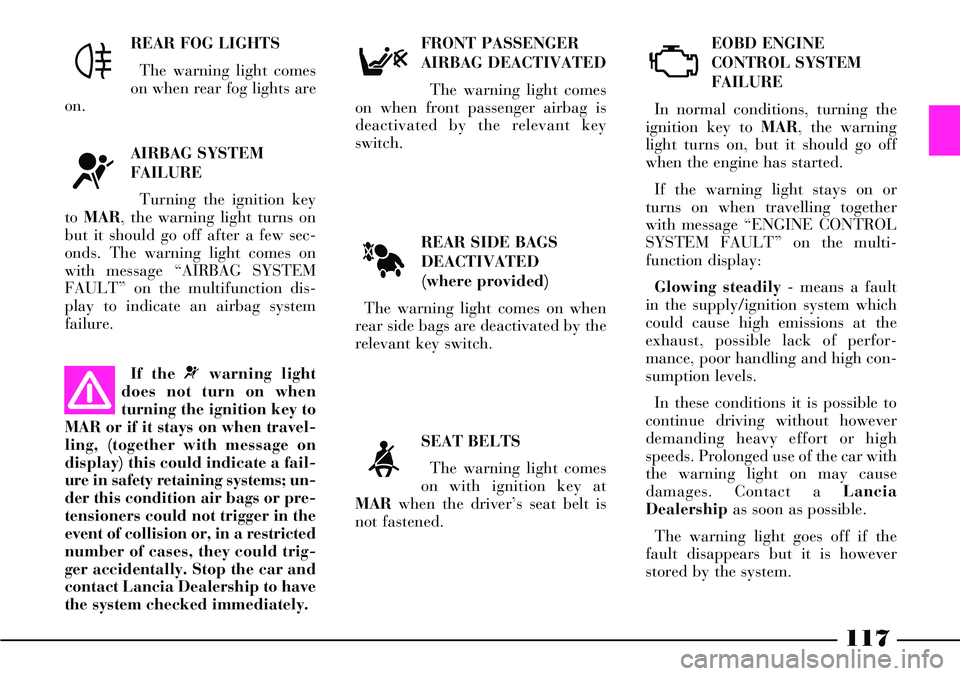
117
REAR SIDE BAGS
DEACTIVATED
(where provided)
The warning light comes on when
rear side bags are deactivated by the
relevant key switch.EOBD ENGINE
CONTROL SYSTEM
FAILURE
In normal conditions, turning the
ignition key to MAR, the warning
light turns on, but it should go off
when the engine has started.
If the warning light stays on or
turns on when travelling together
with message “ENGINE CONTROL
SYSTEM FAULT” on the multi-
function display:
Glowing steadily- means a fault
in the supply/ignition system which
could cause high emissions at the
exhaust, possible lack of perfor-
mance, poor handling and high con-
sumption levels.
In these conditions it is possible to
continue driving without however
demanding heavy effort or high
speeds. Prolonged use of the car with
the warning light on may cause
damages. Contact a Lancia
Dealershipas soon as possible.
The warning light goes off if the
fault disappears but it is however
stored by the system. FRONT PASSENGER
AIRBAG DEACTIVATED
The warning light comes
on when front passenger airbag is
deactivated by the relevant key
switch.
SEAT BELTS
The warning light comes
on with ignition key at
MARwhen the driver’s seat belt is
not fastened.
F
<
U
À
REAR FOG LIGHTS
The warning light comes
on when rear fog lights are
on.
AIRBAG SYSTEM
FAILURE
Turning the ignition key
to MAR, the warning light turns on
but it should go off after a few sec-
onds. The warning light comes on
with message “AIRBAG SYSTEM
FAULT” on the multifunction dis-
play to indicate an airbag system
failure.
4
¬
If the ¬warning light
does not turn on when
turning the ignition key to
MAR or if it stays on when travel-
ling, (together with message on
display) this could indicate a fail-
ure in safety retaining systems; un-
der this condition air bags or pre-
tensioners could not trigger in the
event of collision or, in a restricted
number of cases, they could trig-
ger accidentally. Stop the car and
contact Lancia Dealership to have
the system checked immediately.
Page 140 of 386
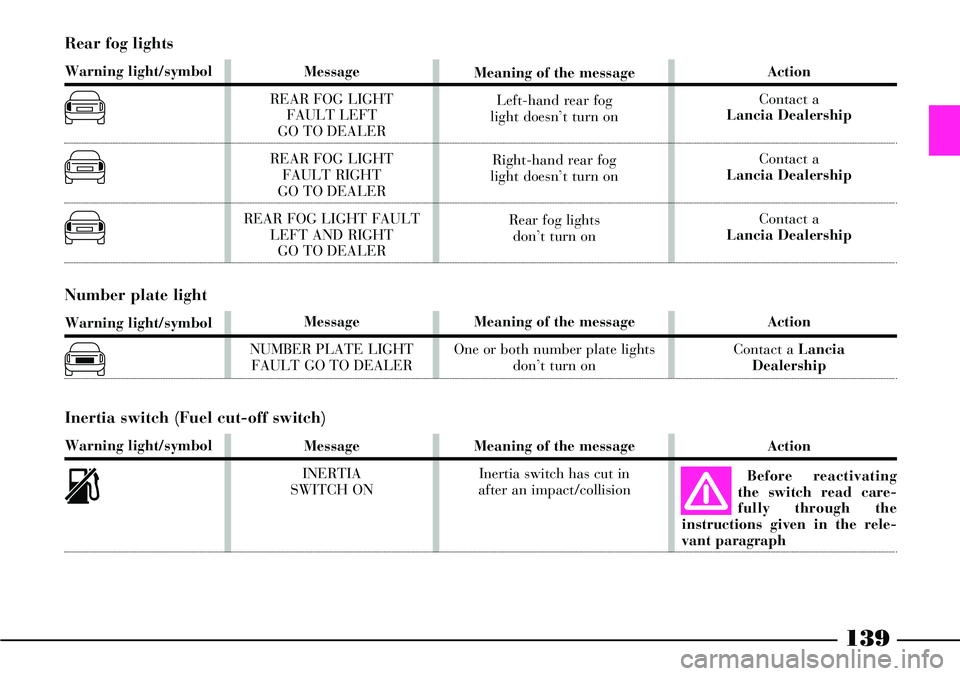
Action
Before reactivating
the switch read care-
fully through the
instructions given in the rele-
vant paragraph
139
Rear fog lights
Warning light/symbol
o
p
q
Message
REAR FOG LIGHT
FAULT LEFT
GO TO DEALER
REAR FOG LIGHT
FAULT RIGHT
GO TO DEALER
REAR FOG LIGHT FAULT
LEFT AND RIGHT
GO TO DEALERMeaning of the message
Left-hand rear fog
light doesn’t turn on
Right-hand rear fog
light doesn’t turn on
Rear fog lights
don’t turn onAction
Contact a
Lancia Dealership
Contact a
Lancia Dealership
Contact a
Lancia Dealership
Number plate light
Warning light/symbol
r
Message
NUMBER PLATE LIGHT
FAULT GO TO DEALERMeaning of the message
One or both number plate lights
don’t turn onAction
Contact a Lancia
Dealership
Inertia switch (Fuel cut-off switch)
Warning light/symbol
s
Message
INERTIA
SWITCH ONMeaning of the message
Inertia switch has cut in
after an impact/collision
Page 172 of 386
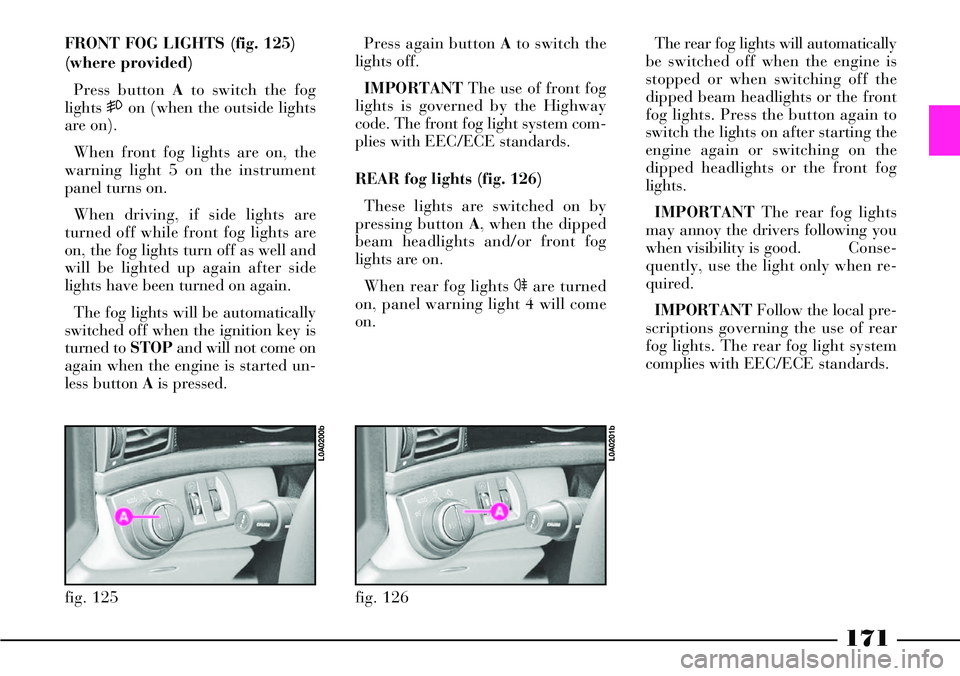
171
FRONT FOG LIGHTS (fig. 125)
(where provided)
Press button Ato switch the fog
lights 5on (when the outside lights
are on).
When front fog lights are on, the
warning light 5 on the instrument
panel turns on.
When driving, if side lights are
turned off while front fog lights are
on, the fog lights turn off as well and
will be lighted up again after side
lights have been turned on again.
The fog lights will be automatically
switched off when the ignition key is
turned to STOPand will not come on
again when the engine is started un-
less button Ais pressed.Press again button Ato switch the
lights off.
IMPORTANTThe use of front fog
lights is governed by the Highway
code. The front fog light system com-
plies with EEC/ECE standards.
REAR fog lights (fig. 126)
These lights are switched on by
pressing button A, when the dipped
beam headlights and/or front fog
lights are on.
When rear fog lights 4are turned
on, panel warning light 4 will come
on.
fig. 125
L0A0200b
fig. 126
L0A0201b
The rear fog lights will automatically
be switched off when the engine is
stopped or when switching off the
dipped beam headlights or the front
fog lights. Press the button again to
switch the lights on after starting the
engine again or switching on the
dipped headlights or the front fog
lights.
IMPORTANTThe rear fog lights
may annoy the drivers following you
when visibility is good.Conse-
quently, use the light only when re-
quired.
IMPORTANTFollow the local pre-
scriptions governing the use of rear
fog lights. The rear fog light system
complies with EEC/ECE standards.
Page 259 of 386
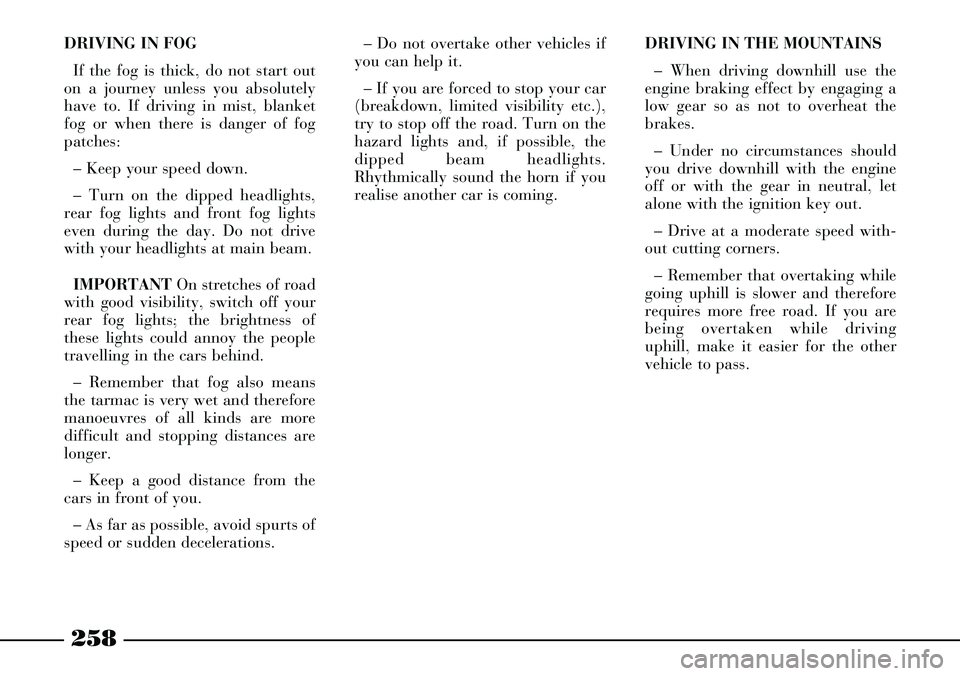
258
DRIVING IN FOG
If the fog is thick, do not start out
on a journey unless you absolutely
have to. If driving in mist, blanket
fog or when there is danger of fog
patches:
– Keep your speed down.
– Turn on the dipped headlights,
rear fog lights and front fog lights
even during the day. Do not drive
with your headlights at main beam.
IMPORTANTOn stretches of road
with good visibility, switch off your
rear fog lights; the brightness of
these lights could annoy the people
travelling in the cars behind.
– Remember that fog also means
the tarmac is very wet and therefore
manoeuvres of all kinds are more
difficult and stopping distances are
longer.
– Keep a good distance from the
cars in front of you.
– As far as possible, avoid spurts of
speed or sudden decelerations. – Do not overtake other vehicles if
you can help it.
– If you are forced to stop your car
(breakdown, limited visibility etc.),
try to stop off the road. Turn on the
hazard lights and, if possible, the
dipped beam headlights.
Rhythmically sound the horn if you
realise another car is coming. DRIVING IN THE MOUNTAINS
– When driving downhill use the
engine braking effect by engaging a
low gear so as not to overheat the
brakes.
– Under no circumstances should
you drive downhill with the engine
off or with the gear in neutral, let
alone with the ignition key out.
– Drive at a moderate speed with-
out cutting corners.
– Remember that overtaking while
going uphill is slower and therefore
requires more free road. If you are
being overtaken while driving
uphill, make it easier for the other
vehicle to pass.
Page 261 of 386
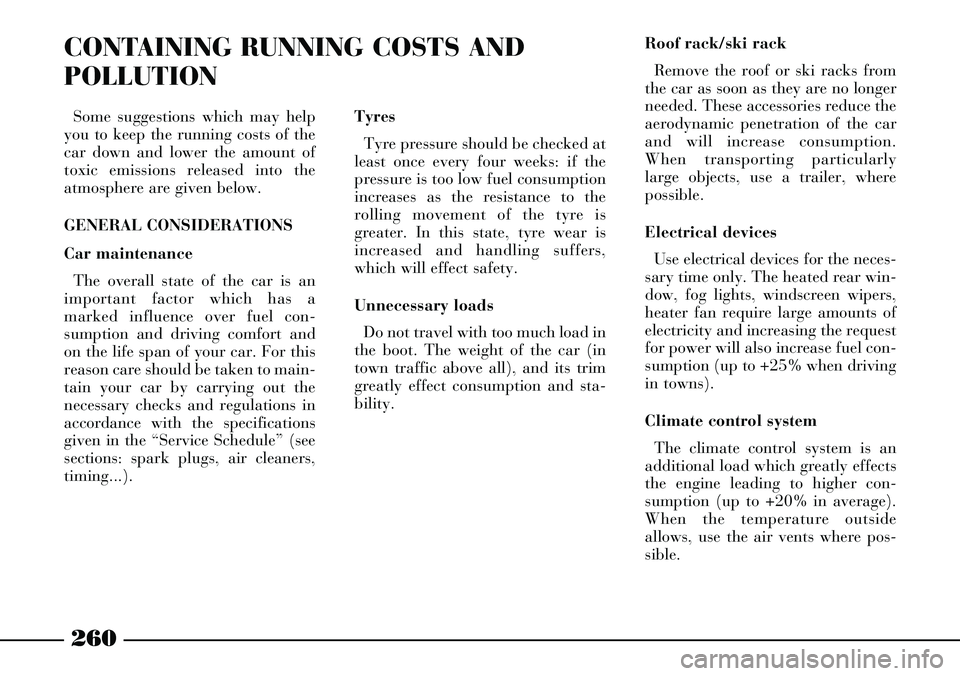
260
CONTAINING RUNNING COSTS AND
POLLUTION
Some suggestions which may help
you to keep the running costs of the
car down and lower the amount of
toxic emissions released into the
atmosphere are given below.
GENERAL CONSIDERATIONS
Car maintenance
The overall state of the car is an
important factor which has a
marked influence over fuel con-
sumption and driving comfort and
on the life span of your car. For this
reason care should be taken to main-
tain your car by carrying out the
necessary checks and regulations in
accordance with the specifications
given in the “Service Schedule” (see
sections: spark plugs, air cleaners,
timing...).Tyres
Tyre pressure should be checked at
least once every four weeks: if the
pressure is too low fuel consumption
increases as the resistance to the
rolling movement of the tyre is
greater. In this state, tyre wear is
increased and handling suffers,
which will effect safety.
Unnecessary loads
Do not travel with too much load in
the boot. The weight of the car (in
town traffic above all), and its trim
greatly effect consumption and sta-
bility.Roof rack/ski rack
Remove the roof or ski racks from
the car as soon as they are no longer
needed. These accessories reduce the
aerodynamic penetration of the car
and will increase consumption.
When transporting particularly
large objects, use a trailer, where
possible.
Electrical devices
Use electrical devices for the neces-
sary time only. The heated rear win-
dow, fog lights, windscreen wipers,
heater fan require large amounts of
electricity and increasing the request
for power will also increase fuel con-
sumption (up to +25% when driving
in towns).
Climate control system
The climate control system is an
additional load which greatly effects
the engine leading to higher con-
sumption (up to +20% in average).
When the temperature outside
allows, use the air vents where pos-
sible.
Page 265 of 386
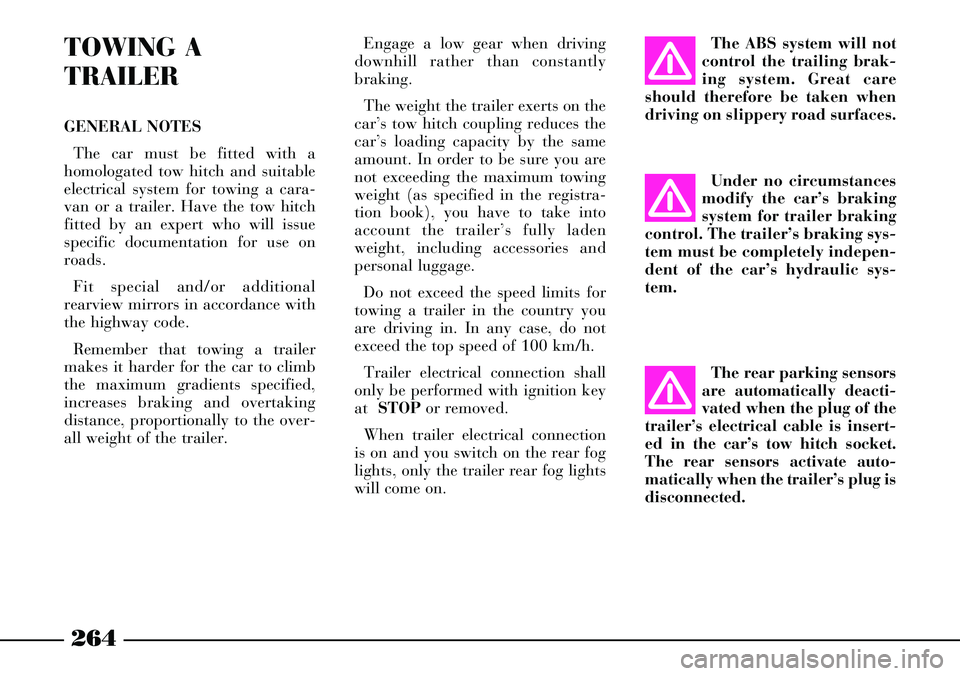
264
TOWING A
TRAILER
GENERAL NOTES
The car must be fitted with a
homologated tow hitch and suitable
electrical system for towing a cara-
van or a trailer. Have the tow hitch
fitted by an expert who will issue
specific documentation for use on
roads.
Fit special and/or additional
rearview mirrors in accordance with
the highway code.
Remember that towing a trailer
makes it harder for the car to climb
the maximum gradients specified,
increases braking and overtaking
distance, proportionally to the over-
all weight of the trailer.Engage a low gear when driving
downhill rather than constantly
braking.
The weight the trailer exerts on the
car’s tow hitch coupling reduces the
car’s loading capacity by the same
amount. In order to be sure you are
not exceeding the maximum towing
weight (as specified in the registra-
tion book), you have to take into
account the trailer’s fully laden
weight, including accessories and
personal luggage.
Do not exceed the speed limits for
towing a trailer in the country you
are driving in. In any case, do not
exceed the top speed of 100 km/h.
Trailer electrical connection shall
only be performed with ignition key
at STOPor removed.
When trailer electrical connection
is on and you switch on the rear fog
lights, only the trailer rear fog lights
will come on.The ABS system will not
control the trailing brak-
ing system. Great care
should therefore be taken when
driving on slippery road surfaces.
Under no circumstances
modify the car’s braking
system for trailer braking
control. The trailer’s braking sys-
tem must be completely indepen-
dent of the car’s hydraulic sys-
tem.
The rear parking sensors
are automatically deacti-
vated when the plug of the
trailer’s electrical cable is insert-
ed in the car’s tow hitch socket.
The rear sensors activate auto-
matically when the trailer’s plug is
disconnected.
Page 284 of 386
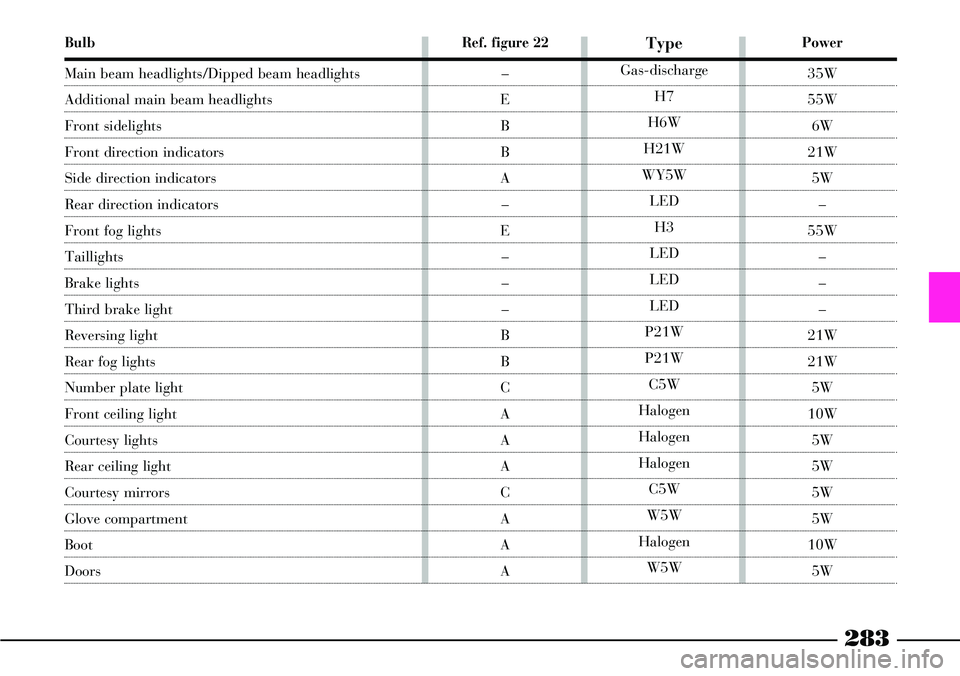
283
Bulb
Main beam headlights/Dipped beam headlights
Additional main beam headlights
Front sidelights
Front direction indicators
Side direction indicators
Rear direction indicators
Front fog lights
Taillights
Brake lights
Third brake light
Reversing light
Rear fog lights
Number plate light
Front ceiling light
Courtesy lights
Rear ceiling light
Courtesy mirrors
Glove compartment
Boot
Doors
Power
35W
55W
6W
21W
5W
–
55W
–
–
–
21W
21W
5W
10W
5W
5W
5W
5W
10W
5W
Type
Gas-discharge
H7
H6W
H21W
WY5W
LED
H3
LED
LED
LED
P21W
P21W
C5W
Halogen
Halogen
Halogen
C5W
W5W
Halogen
W5W
Ref. figure 22
–
E
B
B
A
–
E
–
–
–
B
B
C
A
A
A
C
A
A
A